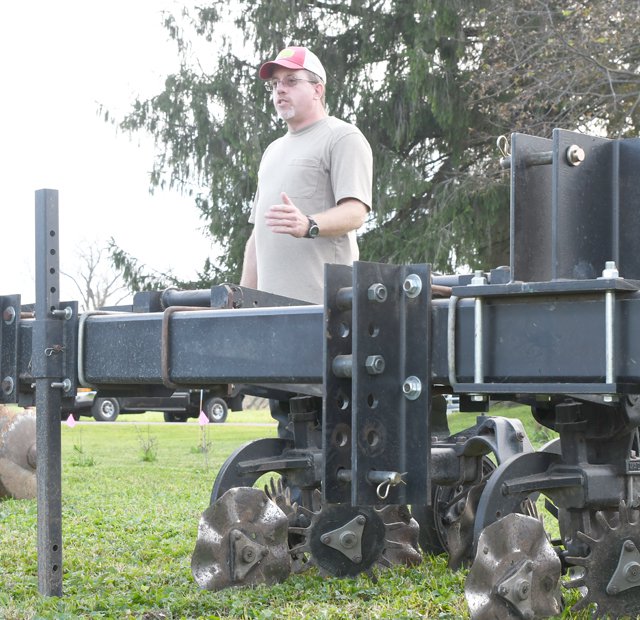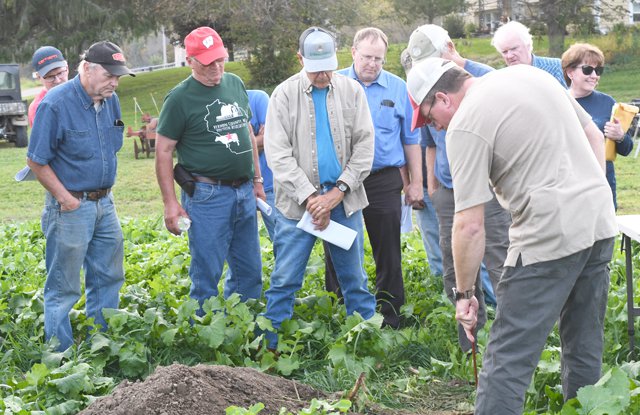COON CREEK - Almost 20 farmers and interested community members gathered at the farm of sweet corn grower Kevin Traastad for a meeting of the Coon Creek Community Watershed Council on September 29. Traastad’s farm is located a few miles northeast of Coon Valley, in the valley of Coon Creek.
Three county conservationists attended the meeting. This reflects the fact that the Coon Creek Watershed lies in all three counties. Those county conservationists were Ben Wojahn of Vernon County, Bob Micheel of Monroe County and Matt Hanewall of LaCrosse County.
Since the breach of flood control dams in 2018 following a catastrophic rainfall event, the three counties have been collaborating on watershed studies that will determine the future of those dams. More recently, they have been working with landowners to pursue regenerative land management solutions that can help address the flooding from increasingly large and intense rainfall events.
In addition, the group has support from the Coon Valley Business Association, the Town of Coon, and the Village of Coon Valley. Other partners that have expressed interest in collaboration with the group to help them further their goals include Wisconsin State Senator Brad Pfaff, State Representative Loren Oldenburg, Wisconsin Farm Bureau, Wisconsin Farmers Union, Vernon Economic Development Corporation, Chaseburg Farmers Co-op, UW-Extension, Grasslands 2.0, Sand County Foundation, Fishers & Farmers Partnership, Valley Stewardship Network, Organic Valley and more.
Grant application
Wojahn updated the group on work of a sub-committee that had submitted an application for a Department of Agriculture, Trade and Consumer Protection (DATCP) Producer-Led Watershed Council grant. The group has requested the full $40,000 amount potentially available from the program.
In their application, the group describes their first-year start up goals as:
• seeking assistance in developing a mission statement, goals and work plan
• facilitating an increase in acres planted in cover crops or other perennial crops in the watershed
• identifying areas in the watershed where installation of conservation practices will give the ‘biggest bang for the buck’
• provide educational events to help producers hone their understanding of how to pursue farm profitability, soil health, water quality, and improved water infiltration
• outreach to help the non-farming community understand the efforts that farmers are making.
Next meeting
The group discussed when and where to hold their next meeting. They decided they would meet inside at a location in the Village of Coon Valley to be decided, on Wednesday, Nov. 3, at 7 p.m.
The group also agreed that Nancy Wedwick would be the group’s coordinator, helping to take minutes of meetings, send out agendas, and maintaining the mailing list. Anyone wanting to be added to the distribution list for upcoming meeting announcements can reach Wedwick at nancywedwick45@gmail.com.

Traastad operation
Coon Valley sweet corn farmers Kevin and Maggie Traastad took the time to explain their operation to meeting attendees, and discuss their efforts to improve soil health on the farm.
Kevin Traastad, who grew up on the farm, explained that the main crops grown on the farm over the years had been tobacco and sweet corn. A diversion on the farm had allowed one field to be used for continuous tobacco, and the rest was corn on corn, or alfalfa. As many as four tillage passes would be made over the ground per season.
Kevin explained that he began to see the need to do something different on the land following the back-to-back catastrophic rainfall and flooding events in 2007 and 2008.
“In those rain events, we experienced sheets of soil running off, carrying nutrients into the creek, and depositing soil, rocks and debris on our fields,” Traastad remembered. “Maggie and I pick all of our sweet corn by hand, and at times we would be up to our ankles in mud.”
The two moved back to the farm in 2009, and according to Kevin, realized that they need to make some changes in their land management. At first, he pursued more advanced tillage implements and practices. However, he has increasingly realized that what he wants to do is to pursue a viable no-till strategy for his operation combined with use of cover crops to build soil health.
His first purchase was a soil finisher, which would spread out the post harvest trash. The second implement was a custom-built strip tiller. Traastad obtained the plans from another farmer, and had the toolbar built, and strip till row units attached by Chaseburg Manufacturing. He reported issues using this device on steeper slopes.
“None of these approaches have achieved the goals I have for the farm,” Traastad explained. “My new goal is to transition to a system of planting into a two-inch tall cover crop mulch with zero tillage.”
He said that the August 2018, and August 7, 2021, rain events had further solidified him in his intentions to pursue a more regenerative approach on his acres. He said that his previous management changes had helped, and he has more earthworms in his soil than ever. Nevertheless, he said “we still have a long way to go.”
“In the 2018 event, if we’d gotten just one more foot of floodwater, we would have had water in our house which is well out of the 100-year floodplain,” Traastad said. “Last month, the water was up to the bottom of our fire number sign, and after supper, Maggie and I just sat out in our yard and watched the water rush by – there was nowhere we could go at that point.”


Cover crops
Traastad treated the group to a viewing of a vibrant field of mixed species cover crops that had been seeded on August 21, after the corn harvest. The forage radishes, turnips and rye planting was already over a foot tall, and as Traastad pointed out, “there’s no frost in sight.”
Next spring, Traastad said, the field will be planted into oats and clover, and then into sweet corn in 2023. He said that the radishes and turnips growing this year will die after frost, and he plans to terminate the rye in April or May of 2022.

“By planting these cover crops in the field, I’m hoping to tie up nutrients that weren’t used by the sweet corn,” Traastad said. “By tying up the nutrients, I can preserve the investment I made in them, capture it for the next corn crop, and prevent the nutrients from leaching through the soil profile and into the aquifer.”
Traastad said that generally the soil organic matter in his fields is all over three percent. LaCrosse County Conservationist Matt Hanewall observed that with the management shifts in his operation, Traastad would likely improve soil organic matter into the five-to-six percent range.
“If we can increase the soil organic matter and improve our soil’s structure, we will also improve the water infiltration capacity of the ground,” Traastad said. “The way I see it, in this watershed, farmers have a real infiltration opportunity that will help to solve our runoff problem.”
Vernon County Conservationist Ben Wojahn asked Traastad if he was considering introducing cattle into his operation?
“I have thought about it,” Traastad said. “What I want to avoid though, is compaction from running cattle on the land.”




